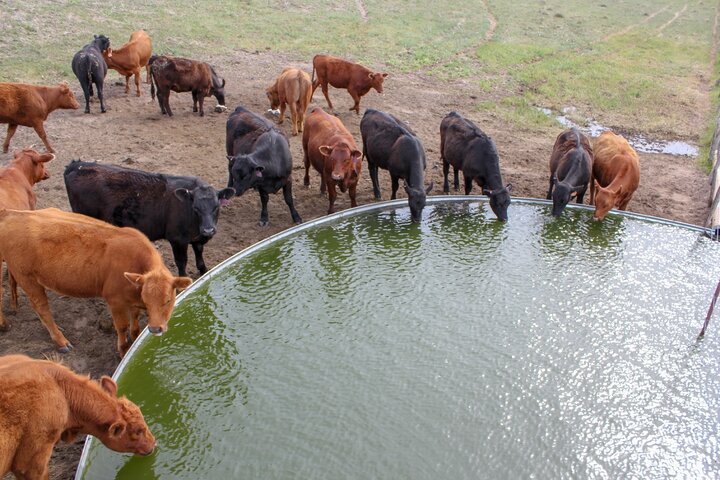For cattle producers who rely on wells in pastures and rangelands as a water source for their cattle, much time is spent checking water to make sure that windmills and submersible wells are delivering the water cattle need. These water checks are often made daily or every other day to ensure water is available. When problems occur with a water source cattle depend on, time is limited to get the problem fixed, haul water or move the cattle to another location where water is. Timeliness of knowing there is a problem with a well or a tank that stores water is essential to being able to correct the problem quickly and avoid the detrimental impacts of cattle being without water.
In the last several years, three technologies have been developed that can significantly reduce the time it takes to check water and know a problem has occurred.
Remote Cameras and Cellular Technology
Remote cameras that communicate with mobile devices by utilizing cellular service are a recent technological development. For much of the United States, cell service is widely available. This technology allows a producer to program a camera to take pictures of a water tank at different times of the day. These pictures can then be automatically sent to a smartphone or other mobile device using email or text, and be viewed to see if a problem is occurring with a water source.
If the level in the water tank is not where it should be, based on a series of pictures taken, the person caring for the cattle can immediately be made aware. The cost ranges from $150 to $750 per camera, plus a monthly data or service fee. Some cameras come with a limited number of pictures that can be delivered per month as part of the purchase package. Solar panels for charging batteries can be added to remote cameras to reduce the frequency that batteries need to be replaced. For areas with poor cellular signals, there are external, high-gain antennas that can boost signal reception. Companies are available to help producers identify the equipment and data plan that they need, as well as set up the cameras and the monitoring system.
Remote cameras can not only save time and travel, but they also can give peace of mind and freedom. Would you like to take a couple of days of vacation? Attend a family member’s activities? Being able to check water from anywhere through your smart phone or mobile device could help you achieve that. Knowing you can look at your mobile device anywhere and see the water levels in a tank gives assurance in knowing that cattle have water.
Remote Sensors and Cellular Technology
Another technology that can be very valuable for producers, who utilize pipelines to deliver water, is a remote pressure sensor. These sensors can transmit pressure readings via cellular signals to mobile devices, which allows for constant monitoring of what is happening in terms of water pressure on a pipeline. When water pressure moves outside of an identified acceptable range, a notification is sent that alerts the user to the potential of a problem. This can be especially valuable for producers who are depending upon a consistent, large volume of water to be delivered to cattle when there is minimal storage capacity at the tank. Should a well go down, electricity shut off, or a float come off at the tank, this monitoring system can quickly alert the person supervising the system.
Remote sensing technology paired with cellular service also allows for monitoring of water levels in storage tanks. Utilizing ultrasonic level sensors, measurements can be programed to be taken at different times of the day and have these measurements delivered to a mobile device. This allows people monitoring water levels in a storage tank to know what is happening without physically being present at the tank location.
Drones and Water Checking Flights
Drones are increasing in availability and decreasing in cost. Using drones with remote cameras for checking water in locations that are difficult to access or without cellular signals could save time and wear on vehicles. By flying directly or utilizing a pre-programmed flight pattern for the drone, the drone can be sent up and the remote camera used to take video or photos as it flies over water tank locations. This requires that the drone be in the line of sight of the operator during the entire flight. Drones can also be used to scan windmills to make sure that from visual inspection, all parts of the windmill are in working order.
Another advantage of using a drone is that it also allows for the opportunity to utilize a “bird’s eye view” to see cattle at the tank and in the pasture to look for cattle that are off by themselves or acting lethargic or sick. This can help the producer quickly see where cattle are and locate them to identify potential health problems. When considering the use of this technology, make sure you understand and are in compliance with all Federal Administration Aviation rules and regulations for using a drone.
Timeliness, Cattle Care and Peace of Mind
Having water available is critically important to the health and performance of cattle. Being able to quickly identify if a problem is occurring with a water source gives producers the opportunity to respond rapidly to correct any issues. Time is of the essence when cattle are out of water. While these technologies won’t be a perfect fit for everyone, being able to check water from afar may save time and money, shorten downtime, and provide peace of mind for those caring for cattle.
Interviews with the authors of BeefWatch newsletter articles become available throughout the month of publication and are accessible at https://go.unl.edu/podcast.
Topics covered:
Grazing systems & best practices, Pasture & range, Pasture & range

